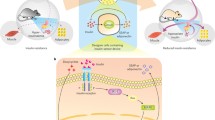Abstract
Type 1 diabetes results from the autoimmune destruction of pancreatic β-cells, which leads to severe insulin deficiency. Insulin gene therapy provides an attractive approach to cure diabetes. The critical factor for insulin gene therapy in surrogate cells is to select an appropriate site for insulin expression and a tissue-specific promoter that is responsive to both physiological glucose and insulin concentrations. A novel chimeric promoter, (GIRE)n-G6Pase, consisting of a 1.6 kb glucose 6-phosphatase (G6Pase) promoter and a segment of the regulatory element derived from the L-type pyruvate kinase (L-PK) promoter, was designed to provide strong and tight control of insulin expression in liver. One or three copies of GIRE were linked to the G6Pase promoter, which showed a stronger promoter activity than the G6Pase promoter alone. The chimeric promoter was inhibited by insulin in a dosage-dependent manner and activated by glucose, two features essential for glucose metabolism. The promoter activity is conserved between species and highly specific for liver cells. The construction of a chimeric promoter with stronger and more sensitive responsive activity to glucose and insulin in liver cells could further advance studies in insulin gene therapy.





Similar content being viewed by others
References
Bach JF (1994) Insulin-dependent diabetes mellitus as an autoimmune disease. Endocr Rev 15:516–542
Yoon JW, Jun HS (2002) Recent advances in insulin gene therapy for type 1 diabetes. Trends in Molecular Medicine 8:62–68
Dong H, Woo SLC (2001) Hepatic insulin production for type 1 diabetes. Trends in Endocrinol Metab 12:441–446
Levine F, Leibowitz G (1999) Towards gene therapy of diabetes mellitus. Molecular Medicine Today 5:165–171
Lee HC, Kim SJ, Kim KS, Shin HC, Yoon JW (2000) Remission in models of type 1 diabetes by gene therapy using a single-chain insulin analogue. Nature 408:483–488
Chen R, Meseck ML, Woo SLC (2001) Auto-regulated hepatic insulin gene expression in type 1 diabetic rats. Mol Ther 3:584–590
Thule PM, Liu JM (2000) Regulated hepatic insullin gene therapy of STZ-diabetic rats. Gene Ther 7:1744–1752
Cheung AT, Dayanandan B, Lewis JT, Korbutt GS, Rajotte RV, Bryer-Ash M, Boylan MO, Wolfe MM, Kieffer TJ (2000) Glucose-dependent insulin release from genetically engineered K cells. Science 290:1959–1962
Bailey CJ, Davies EL, Docherty K (1999) Prospects for insulin delivery by ex-vivo somatic cell gene therapy. J Mol Med 77:244–249
O’Brien RM, Streeper RS, Ayala.JE, Stadelmaier BT, Hornbuckle LA (2001) Insulin-regulated gene expression. Biochem Soc Trans 29:552–558
Lu D, Hoshino H, Takeuchi T (1996) Regulatable production of mature insulin from a hepatocyte cell line: insulin production is up-regulated by cAMP and glucocorticoids, and down-regulated by insulin. FEBS Lett 399:37–42
Scott DK, O’Doherty RM, Stafford JM, Newgard CB, Granner DK (1998) The repression of hormone-activated PEPCK gene expression by glucose is insulin-independent but requires glucose metabolism. J Biol Chem 273:24145–24151
Thule PM, Liu I, Phillps LS (2000) Glucose regulated production of human insulin in rat hepatocytes. Gene Therapy 7:205–214
Bergot MO, Diaz-Guerra MM, Puzenat N, Raymondjean M, Kahn A (1992) Cis-regulation of the L-type pyruvate kinase gene promoter by glucose, insulin and cyclic AMP. NuclAcids Res 20:1871–1878
Argaud D, Zhang Q, Pan W, Maitra S, Pilkis SJ, Lange AJ (1996) Regulation of rat liver glucose-6-phosphatase gene expression in different nutritional and hormonal states: gene structure and 5’-flanking sequence. Diabetes 45:1563–1571
Ashmore J, Weber G (1959) The role of hepatic glucose-6-phosphatase in the regulation of carbohydrate metabolism. Vitam Horm 17:91–132
Shih HM, Towle H (1992) Definition of the carbohydrate response element of the rat S14 gene. J Biol Chem 267:13222–13228
Shih HM, Liu Z, Towle HC (1995) Two CACGTG motifs with proper spacing dictate the carbohydrate regulation of hepatic gene trasncription. J.Biol.Chem. 270:21991–21997
Portois L, Maget B, Tastenoy M, Perret J, Svoboda M (1999) Identification of a glucose response element in the promoter of the rat glucagon receptor gene. J Biol Chem 274:8181–8190
Alam T, Sollinger HW (2002) Glucose-regulated insulin production in hepatocytes. Transplantation 74:1781–1787
Chen R, Meseck M, McEvoy RC, Woo SLC (2000) Glucose-stimulated and self-limiting insulin production by glucose 6-phosphatase promoter driven insulin expression in hepatoma cells. Gene Therapy 7:1802–1809
Schmoll D, Allan BB, Burchell A (1996) Cloning and sequencing of the 5′ region of the human glucose-6-phosphatase gene: transcriptional regulation by CAMP, insulin and glucocorticoids in H4IIE hepatoma cells. FEBS Lett 383:63–66
Yeung CM, Wong CK, Chung SK, Chung SS, Chow BK (1999) Glucose-dependent insulinotropic polypeptide gene expression in the stomach: revealed by a transgenic mouse study, in situ hybridization and immunohistochemical staining. Mol Cell Endocrinol 154:161–170
Stewart C, Taylor NA, Green IC, Docherty K, Bailey CJ (1994) Insulin-releasing pituitary cells as a model for somatic cell gene therapy in diabetes mellitus. J Endocrinol 142:339–343
Hughes SD, Quaade C, Johnson JH, Ferber S, Newgard CB (1993) Transfection of AtT20ins cells with Glut-2 but not Glut-1 confers glucose-stimulated insulin secretion. Relationship to glucose metabolism. J Biol Chem 268:15205–15212
Gould GW, Holman GD (1993) The glucose transporter family: structure, function, and tissue-sepcific expression. Biochem J 295:329–341
Lynedijian PB (1993) Mammalian glucokinase and its gene. Biochem J 293:1–13
Burcelin R, Dolci W, Thorens R (2000) Glucose sensing by the hepatoportal sensor is Glut2-dependent. Diabetes 49:1643–1648
Kahn A (1997) Transcriptional regulation by glucose in the liver. Biochemistry 79:113–118
Acknowledgments
This work was supported by funds from the Research Institute for Children, Children’s Hospital, New Orleans.
Author information
Authors and Affiliations
Corresponding author
Additional information
Mr. James Chong was a senior student in the Department of Cell and Molecular Biology, Tulane University. His independent study project was partially overlapped with this study.
Rights and permissions
About this article
Cite this article
Lan, M.S., Wang, HW., Chong, J. et al. Coupling of glucose response element from L-type pyruvate kinase and G6Pase promoter enhances glucose responsive activity in hepatoma cells. Mol Cell Biochem 300, 191–196 (2007). https://doi.org/10.1007/s11010-006-9383-4
Received:
Accepted:
Published:
Issue Date:
DOI: https://doi.org/10.1007/s11010-006-9383-4




